 On March 1, 1954, fallout from the United States’ Castle Bravo nuclear test on Bikini Atoll rained down on the 140-ton tuna boat Daigo Fukury Maru contaminating its twenty-three man crew. All suffered from acute radiation sickness and one eventually succumbed. According to the Japan Times, his last words were, “I pray that I am the last victim of an atomic or hydrogen bomb.”
On March 1, 1954, fallout from the United States’ Castle Bravo nuclear test on Bikini Atoll rained down on the 140-ton tuna boat Daigo Fukury Maru contaminating its twenty-three man crew. All suffered from acute radiation sickness and one eventually succumbed. According to the Japan Times, his last words were, “I pray that I am the last victim of an atomic or hydrogen bomb.”
Movie producer Tomoyuki Tanaka considered all this on a plane ride home from Indonesia. His latest picture having fallen through, he flew home facing a hole in Toho Studio’s winter release schedule (which used to be what the summer schedule is today for American studios). In all likelihood, a clutch of manic bosses looking for a hit, fast, waited for him at home. The American monster picture King Kong had just enjoyed a international re-release the previous year, mulching a bumper crop of American giant monster films with all that lovely money it brought in. Including The Beast from 20,000 Fathoms, a film about a giant dinosaur awakened by fictional nuclear testing in the Arctic Circle, which eventually attacks New York City. What if, Tanaka wondered, a giant monster, awakened by the actual American nuclear tests going on in the Pacific Rim, attacked Tokyo?
Tanaka took this idea home and the studio brass loved it, handing him one of Toho’s rising stars, director Ishiro Honda, a former-POW and long time friend of Akira Kurosawa. Tanaka, and the severely under-profiled Takeo Murata, banged out a script in less than a month and asked Honda’s favorite special effects director, Eiji Tsuburaya, to build them a monster. Tsuburaya built several.
Eventually, the filmmakers settled on an upright, bulky, 1950s-tyrannosaurus with a forest of stegosaurus plates jutting from its back. A hulking monstrosity, it would breath fire like any good dragon god and prove impervious to conventional military forces. It would be a living embodiment of the horrific destructive powers unleashed upon Japan, and the wider world, halfway through the twentieth century. Forces that still haunt us today however much we try to suppress them with noise. Fifty years after Godzilla’s birth over twenty-three thousand nuclear warheads still sully the world. They sleep, like the Old Ones, waiting for their time.
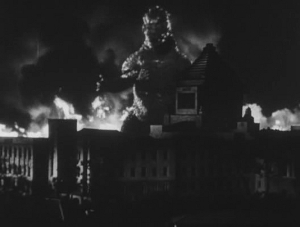 In this film’s time – the eternal 1954 – the Southern Sea Steamship Company freighter Eiko-Maru vanishes amidst a flaming ocean and frantic radio transmissions. (Watch for the radio operator so hydrophobic he keels over and dies on contact with the merest spritz.) At the other end of these transmissions, a phone call to Southern Sea’s head young-person, Hideto Ogata (Akira Takarada) forces him to cancel a date with his friend-who-happens-to-be-a-girl, Emiko Yamane (Momoko Kôchi). The ship sent to rescue the Eiko-Maru‘s crew meets a similar, fiery fate…as does the boat from nearby Odo Island sent to rescue them. A lone survivor washes ashore and remains conscious just long enough to declare, “He did it…a monster.”
In this film’s time – the eternal 1954 – the Southern Sea Steamship Company freighter Eiko-Maru vanishes amidst a flaming ocean and frantic radio transmissions. (Watch for the radio operator so hydrophobic he keels over and dies on contact with the merest spritz.) At the other end of these transmissions, a phone call to Southern Sea’s head young-person, Hideto Ogata (Akira Takarada) forces him to cancel a date with his friend-who-happens-to-be-a-girl, Emiko Yamane (Momoko Kôchi). The ship sent to rescue the Eiko-Maru‘s crew meets a similar, fiery fate…as does the boat from nearby Odo Island sent to rescue them. A lone survivor washes ashore and remains conscious just long enough to declare, “He did it…a monster.”
Odo Island’s resident Old Codger knows what’s what: the ancient, maiden-devouring monster Go-djee-ra is once again awake and angry. The absence of fish in the islander’s nets and the Sole Survivor’s testimony prove it…but other, younger, forward-looking islanders spurn the old man’s superstitious nonsense. Shipping company investigators are on their way from Japan via that marvel of modern technology, the helicopter, and who can afford to look backward by spouting off about sea monsters in front of the city slickers?
The Islanders answer as many questions as they’re comfortable with and put on a nice little anti-Godzilla exorcism ritual for the visit suits…but that old Odo Island mojo seems pretty rusty, considering what follows. That very night, a typhoon blows up from pretty-much nowhere, its lightning, rain, and wind accompanied by a distinctive, thrilling roar, and the not-far-enough-away bomb-blast of gigantic footsteps. Someone must’ve left the exorcism ceremony set on “lure.”
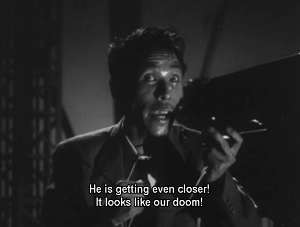 The official inquest in Tokyo amounts to a whole lot of clapping and conflicting eyewitness reports…until Emiko’s dad, “expert paleontologist Professor Kyohei Yamane” (Takashi Shimura, internationally renown for the role he took that same year, in Kurosawa’s Seven Samurai), seizes the initiative by calling for a full-on fact-finding mission back to Odo Island. His hot daughter, Emiko, comes along as a matter of course, and the Southern Sea Steamship Co. sends Ogata since he won the “Best Looking in Those Stupid Little Sailor Hats We Have to Wear Outside the Office” contest. You can tell he’s trying to keep it professional with Emiko despite the fact they were obviously jumping each other’s bones moments before he got the initial call to action.
The official inquest in Tokyo amounts to a whole lot of clapping and conflicting eyewitness reports…until Emiko’s dad, “expert paleontologist Professor Kyohei Yamane” (Takashi Shimura, internationally renown for the role he took that same year, in Kurosawa’s Seven Samurai), seizes the initiative by calling for a full-on fact-finding mission back to Odo Island. His hot daughter, Emiko, comes along as a matter of course, and the Southern Sea Steamship Co. sends Ogata since he won the “Best Looking in Those Stupid Little Sailor Hats We Have to Wear Outside the Office” contest. You can tell he’s trying to keep it professional with Emiko despite the fact they were obviously jumping each other’s bones moments before he got the initial call to action.
In retrospect, he should’ve enjoyed what’ll probably be the last peaceful cruise with his sweetheart ever. Our Heroes find a scaly, fifty-meter-tall, radioactive mass of facts once they arrive back at now-devastated Odo Island. Godzilla, here, comes to life through an assortment of rod puppets and mate paintings. We’ll discuss the rest of Eiji Tsuburaya’s work later. Sufficient to say Our Heroes escape the island inexplicably alive and it’s time for Professor Yamane to define the cement the role of a Scientist in a giant monster movie by making Expository Speech to the Diet.
Millions of years ago (he theorizes) an amphibious dinosaur found a niche for itself deep in oceanic trenches off Odo Island. “However, recent experimental nuclear detonations may have drastically altered its natural habitat.” Professor Yamane: King of the Understatements. The honored professor incorrectly pegs the Jurassic Period, Godzilla’s point of origin, at only two million years in the past. But I’ll forgive him since this is, after all, 1954. Yamane probably doesn’t believe in continental drift yet, either. Poor man would make James “The Amazing” Randi label him a “pseudoscientist” were he to testify today. Such is the march of Progress that American films of the same vintage trumpeted ad nauseum.
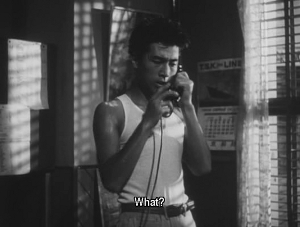 Yamane’s theory moves his audience to heated debate. Not over Godzilla. No, these well-dressed heads of state consider the much more pressing issue of whether or not to keep Yamane’s report from the public. I applaud whomever came up with this bit. Brilliantly true to life, it shows the film’s real strength: a stark, cynical realism, almost noirish in its low opinion of societal authority figures. All through his life, director Honda insisted most of this film came straight from his war-time experiences. There is a Home Front vibe to the little scenes of daily life in rebuilt, post-Occupation Tokyo Honda scatters about the main plot. Random civilians complain about “the shelters…again!” Crowds mill in anonymous, official-looking hallways. The Navy peppers Godzilla’s suspected home with depth-charges and all seems right with the world for a time.
Yamane’s theory moves his audience to heated debate. Not over Godzilla. No, these well-dressed heads of state consider the much more pressing issue of whether or not to keep Yamane’s report from the public. I applaud whomever came up with this bit. Brilliantly true to life, it shows the film’s real strength: a stark, cynical realism, almost noirish in its low opinion of societal authority figures. All through his life, director Honda insisted most of this film came straight from his war-time experiences. There is a Home Front vibe to the little scenes of daily life in rebuilt, post-Occupation Tokyo Honda scatters about the main plot. Random civilians complain about “the shelters…again!” Crowds mill in anonymous, official-looking hallways. The Navy peppers Godzilla’s suspected home with depth-charges and all seems right with the world for a time.
Then Godzilla comes to Tokyo. We all know what happens next and this film is the reason why. The eighth-highest grossing film of the year in its home market, Godzilla became the first piece of Japanese popular culture to achieve global success, reaching billions of eyes throughout its fifty years of continuous viewing, creating a paradigm the Japanese movie industry slavishly follows to this day.
Godzilla makes an initial nighttime foray into Tokyo unopposed. The military, finally moved to action, gets the hot idea to erect an electric barbwire fence along the coast, park some tanks behind that, and pray the whole thing holds. It doesn’t. Obviously miffed by this pitiful, human resistance, Godzilla reduces Tokyo to a fiery, Boshian hellscape, flattening national landmarks with a casual disregard for the tanks, planes, and screaming crowds unlucky enough to cross his path. This sequence is the dark, hot heart of the picture, an orgy of destruction with none of the glossy spectacle you’d see in contemporary (or modern) productions. Honda’s gray scale palette (a cost-cutting measure as much as an artistic choice) and from-the-ground-up camera work combines with Tsuburaya’s creature effects to give Godzilla a life his stiff, latex-and-bamboo body would otherwise sorely lack. Worldwide efforts to ape everyone’s groundbreaking work here have, with few exceptions, failed, and in order to understand why we must first understand what Godzilla does so well.
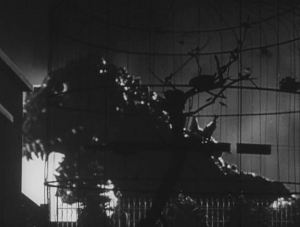 But first, the Third Act, for Godzilla’s rampage caps the Second. We, through the person of Ogata, catch up to Emiko amidst the crying, newly-minted orphans in one of Tokyo’s (we assume) many, many, many triage hospitals. Distraught over the burned bodies, irradiated kids, and the all-around failure to stop Godzilla, Emiko shares a secret with Ogata, one she swore never to reveal:
But first, the Third Act, for Godzilla’s rampage caps the Second. We, through the person of Ogata, catch up to Emiko amidst the crying, newly-minted orphans in one of Tokyo’s (we assume) many, many, many triage hospitals. Distraught over the burned bodies, irradiated kids, and the all-around failure to stop Godzilla, Emiko shares a secret with Ogata, one she swore never to reveal:
Professor Yamane’s obviously hoping Emiko will settle down and raise up a clutch of uberchildren. To that end, he arranged a marriage for Emiko with one of his former students, the eyepatch-rocking Dr. Serizawa (Akihiko Hirata). A chemist by trade, Serizawa’s hung in the background for most of the picture, more concerned with running experiments alone in his basement lab than, say, in the bedroom, with his old professor’s daughter. Hence Emiko’s stepping-out with Ogata, unbeknownst to both her father and her Intended. On the day she dropped by to break the news to Serizawa (whom she swears to Ogata she loves “like a brother”), the lone scientist brought her down to the lab and, before she could get a word out, proceeded to share his deepest, darkest secret.
While working on oxygen, Serizawa discovered “an unknown form of energy” capable of destroying the oxygen in water…along with any oxygenated living tissue that happen to share said water. Watching this “oxygen destroyer” work sends Emiko into Scream Queen Mode and Serizawa claims to have had much the same initial reaction. At the moment, his oxygen destroyer is little more than a Doomsday Weapon…but Serizawa hasn’t forsaken his Movie Scientist’s Optimism. Convinced his discovery will – eventually, somehow, some way – benefit mankind, Serizawa swears Emiko to secrecy as soon as she regains her cool.
One Godzilla attack and some melodramatic agonizing later, Emiko spills the beans to Ogata. Together, they confront the wiggy-haired chemist with a plant to drop the Oxygen Destroy on Godzilla’s undersea kingdom. Serizawa refuses at first, citing the burgeoning Cold War arms race between the superpowers as a case study in what happens when dangerous Super Science debuts in a world unprepared for its consequences. “Of course, they’ll want to use it as a weapon. Bombs versus bombs, missiles versus missiles, and now a new super-weapon to throw upon us all! As a scientist, as a human being, I can’t allow that to happen.”
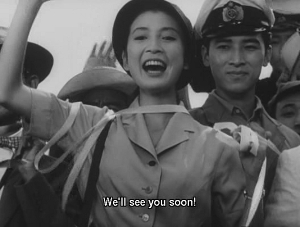 With subtext having become text, Serizawa and Ogata tussle decorously off-screen. As Emiko field-dresses her young hunk, the lab’s tiny television springs to life with scenes of devastated Tokyo, bracketed by an all-girl choir singing, “Oh Peace, Oh Light, Return.” His humanistic heartstrings sufficiently tugged, Serizawa agrees to hand over the Oxygen Destroyer, provided this is “the first and last time” it’s ever used. Emiko once again breaks down and cries as the good doctor sets about burning his notes, and while this weeping Tourette’s Syndrome is a symptom of Emiko’s cultural gender norms, I’d like to think she’s a smart enough character to know exactly what Serizawa means to do later on. Given the national trauma Japan’s just experienced, I imagine everyone’s walking around on egg shells, because what else were people in the industrialized world doing in the 1950s?
With subtext having become text, Serizawa and Ogata tussle decorously off-screen. As Emiko field-dresses her young hunk, the lab’s tiny television springs to life with scenes of devastated Tokyo, bracketed by an all-girl choir singing, “Oh Peace, Oh Light, Return.” His humanistic heartstrings sufficiently tugged, Serizawa agrees to hand over the Oxygen Destroyer, provided this is “the first and last time” it’s ever used. Emiko once again breaks down and cries as the good doctor sets about burning his notes, and while this weeping Tourette’s Syndrome is a symptom of Emiko’s cultural gender norms, I’d like to think she’s a smart enough character to know exactly what Serizawa means to do later on. Given the national trauma Japan’s just experienced, I imagine everyone’s walking around on egg shells, because what else were people in the industrialized world doing in the 1950s?
In any case, Ogata and Serizawa don diving suits and find Godzilla slumbering at the bottom of Tokyo Bay. With a final admonishment that Ogata and Emiko “be happy” Serizawa cuts his own lifeline, allowing the Oxygen Destroyer to reduce him and Godzilla to bleached skeletons, then nothing. Topside, hats and headbands are doffed in appreciation of the Great Man’s noble sacrifice for his country, salutes to the (rising? setting? Honda leaves that an open question) sun. Only Dr. Yamane seems immune to the collective grief and relief around him. “I can’t believe Godzilla was the only surviving member of its species. But if we keep on conducting nuclear tests, it’s possible that another Godzilla might appear somewhere in the world, again.” Obvious parallels exist between Yamane and Serizawa, showcasing the two sides of the Scientist’s role in these pictures and in the wider world. Yamane the elder, respected and statesmanlike;Serizawa the younger, front-line researcher, striking out into the Unknown and (unlike certain American scientists I could name) realizing the consequences of his discoveries before they can be weaponized.
This last bit of shameless didacticism aside, Godzilla is remarkable for its comparatively-subtle, straight-faced approach to subjects both producers and consumers usually dismiss as escapist, fantasy pablum. But the giant monster (as a concept) is so much more than this their continued confinement to various cultural ghettos is almost criminal. Certainly shows a criminal negligence on the part of certain movie makers, including some of those behind this film’s cameras.
But those crimes lay in the future, and Godzilla cannot be properly considered apart from the time and place that gave him birth. The film is, above all else, imminently Japanese, and early scenes of the military’s anti-Godzilla mobilization (scenes Tanaka would shamelessly parrot throughout his next eight Godzilla pictures) are shot through with the nationalistic triumphalism of a young and hungry Empire, still sure of its place despite that Recent Unpleasantness with the Americans. The film’s spare score, written by classically-trained composer Akira Ifukube, adds a lot to this by echoing the nationalistic, war-time marches that initially made him famous. But Ifukube, like Honda, goes on to subvert the very thing he once aggrandized. As Godzilla (literally) walks through Japan’s arrayed military might the score, and Honda’s camera, turn somber, moody and bleak, evoking a mood that should properly nix any audience member’s instinct to laugh at the relative crudity of Tsuburaya’s special effects.
Everyone knows Godzilla as “a living nuclear weapon” (as Professor Yamane’s cinematic descendant, Dr. Hayashida, called him thirty years down the road), but few Americans acknowledge him as a symbolic representation of the twentieth century’s largest scientific-technological juggernaut: the U.S. Armed Forces. As much a walking B-29 bomber as anything else, Godzilla’s fiery stroll is meant to invoke the seven-month long bombing campaign Japan’s capital endured over the course of 1945. That experience left as wide a mark on Japan as Fat Boy or Little Man, and the next time you wonder why monsters are inexplicably drawn to Tokyo remember what the Army codenamed Operation Meetinghouse. In one night, March 10, 1945, over three hundred B-29s carpeted the city with incendiary bombs, annihilating some sixteen miles of real estate and over one hundred thousand human beings.
Recent scholarship suggests that figure may be low, but the point is obvious. It would’ve been even more obvious to a 1950s, Tokyo audience, and Honda consciously showcases the horrific results of Godzilla’s rampages as much as the artistic mores of his time allow. Much of the film involves characters jawing over the initial mystery, and eventual ramifications, of Godzilla’s existence, but Honda’s direction shines in the second half once everyone shuts up and film’s real star arrives. Here we see Kurosawa’s friend and disciple shine, his eye capturing some genuinely arresting imagery. I think it’s safe to call this Honda’s artistic high water mark, unless we count his second unit work on Kagemusha or Ran. Never again would so deft a hand turn to giant monster movie making, and we are all sorrier for it.
Certain Tsuburaya effects conspire to make us sorrier-still, particularly if we’re trying to explain all of the above to friends who keep shouting, “Toy boat! Toy boat!” Godzilla’s realized through a combination of two suits (inhabited by stuntman Haruo Nakajima, who’d go on to play Godzilla in twelve more films) and several rod puppets, none of which look particularly like each other, a sure sign of a rushed special effects house. The toy firetrucks, tanks, planes and (yes) boats date the film as much, if not more, as this. But their scenes are gratefully brief and most come at such brooding moments (right before their alleged occupant’s deaths in most cases) that their presence does not sour the film’s overall effect.
Human characters are the film’s real weakest link, never rising above the level of animating stand-ins. They are as archetypal as the monster they oppose, and just as one-dimensional. The actors are not to be faulted, and all fulfill their roles with a dignity and grace absent other daikaiju pictures. Their reactions to Godzilla are appropriately, believably horrified. Their reactions to each other are constrained by screen time and the cultural gulf that now stretches across time further than it ever stretched across oceans. Shadows in a lost world, they are nevertheless to be commended for deft handling of what must’ve been a damned strange experience.
A great film? Perhaps to some of us. Historic? God yes. A Godzilla film for all ages and all times, eternally bound to its own time and place. Gojira remains the undisputed King of the genre. Without it, your education is incomplete. Without it, I would not be here today.
![]()
![]()
![]()
![]()
![]()

“Fifty years after Godzilla’s birth over twenty-three thousand nuclear warheads still sully the world. They sleep, like the Old Ones, waiting for their time.”
David, i’ve only gotten thru about half your reviews so far, but i’m confident in declaring THIS your Best. Metaphor. Ever.
also, NICE “Obligatory 23” in there!